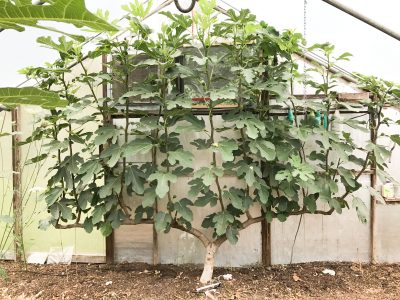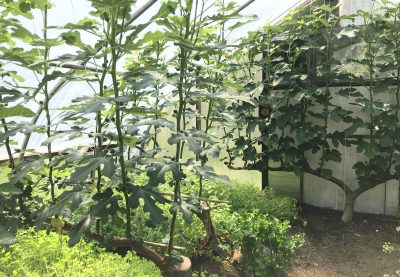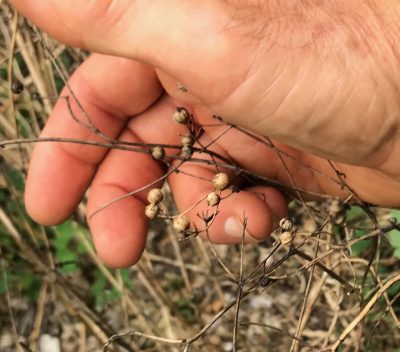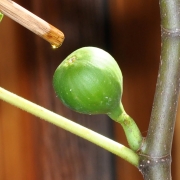Figs and Peppers and . . .
Fig Frustrations and Joys
Over the years I’ve shared the joys and frustrations of growing figs in my minimally heated greenhouse. The joys, of course, have been in sinking my teeth into fruits of the various varieties. Also, more recently, the neat appearance of the plants which are trained as espaliers.  Left to its own devices, a fig can grow into a tangled mess. In part, that’s because fig trees can’t decide if they want to be small trees, with single or a few trunks, or large shrubs, with sprouts and side branches popping out all over the place.
A major frustration in my greenhouse fig journey has been insects, both scale insects and mealybugs. These pests never attack my potted figs which summer outdoors and winter indoors in my barely heated basement. In the greenhouse the problem each year became more and more severe, eventually rendering many of the ripe fruits inedible.
Left to its own devices, a fig can grow into a tangled mess. In part, that’s because fig trees can’t decide if they want to be small trees, with single or a few trunks, or large shrubs, with sprouts and side branches popping out all over the place.
A major frustration in my greenhouse fig journey has been insects, both scale insects and mealybugs. These pests never attack my potted figs which summer outdoors and winter indoors in my barely heated basement. In the greenhouse the problem each year became more and more severe, eventually rendering many of the ripe fruits inedible. All that despite my attempts at control by going over plants with a toothbrush dipped in alcohol, oil sprays, and sticky barriers to keep ants, which “farm” these pests, from climbing up the trunks.
All that despite my attempts at control by going over plants with a toothbrush dipped in alcohol, oil sprays, and sticky barriers to keep ants, which “farm” these pests, from climbing up the trunks.
 Left to its own devices, a fig can grow into a tangled mess. In part, that’s because fig trees can’t decide if they want to be small trees, with single or a few trunks, or large shrubs, with sprouts and side branches popping out all over the place.
A major frustration in my greenhouse fig journey has been insects, both scale insects and mealybugs. These pests never attack my potted figs which summer outdoors and winter indoors in my barely heated basement. In the greenhouse the problem each year became more and more severe, eventually rendering many of the ripe fruits inedible.
Left to its own devices, a fig can grow into a tangled mess. In part, that’s because fig trees can’t decide if they want to be small trees, with single or a few trunks, or large shrubs, with sprouts and side branches popping out all over the place.
A major frustration in my greenhouse fig journey has been insects, both scale insects and mealybugs. These pests never attack my potted figs which summer outdoors and winter indoors in my barely heated basement. In the greenhouse the problem each year became more and more severe, eventually rendering many of the ripe fruits inedible. All that despite my attempts at control by going over plants with a toothbrush dipped in alcohol, oil sprays, and sticky barriers to keep ants, which “farm” these pests, from climbing up the trunks.
All that despite my attempts at control by going over plants with a toothbrush dipped in alcohol, oil sprays, and sticky barriers to keep ants, which “farm” these pests, from climbing up the trunks. Scale and mealybugs are hard to control, let alone eradicate. Yet I am now secure enough in my victory to have claimed success in the battle.
Success began last year, when research pointed me to two predators of these pests, Chrysoperla rufilabris and Cryptolaemus montrouzieri, both of which I ordered online and released into the greenhouse. They were expensive, bringing the cost of my fresh figs to about one dollar each. Still worth it, though.
I got to thinking, “Perhaps I could perennialize these predators in the greenhouse so that additional annual purchases would be unnecessary.” As a first step to creating a home (or a jail, depending on your perspective) for them, I covered all greenhouse openings to the outdoors with window screening. These predators also like moisture, so I periodically spritzed the greenhouse and laid some absorbent wads of paper here and there on the branches.
I further thought, “How does the greenhouse environment differ from the great outdoors, where my figs are pest-free?” Rainfall! Although the greenhouse environment is humid, water never falls on the plants’ leaves and stems. So rather than period spritzing, almost every day since early spring I have blasted leaves, stems, and developing fruits with water. The result: I haven’t seen one mealybug or scale insect all season!
Success, Who Knows Why?
I have to restrain myself from the usual gardener’s hubris in thinking that what I did cured the problem. Perhaps the “rainfall” favored the predators, of which there’s been nary a sign, by knocking the pest insects off the plant, or by creating a moist environment inimical to the pests, or . . . Perhaps my screening the greenhouse cured the problem. Perhaps the pest problem disappeared for none of these reasons. Or from some combination of these reasons.
If I had a full-blown experimental station and was willing to sacrifice some fresh figs to science, I could possible sleuth out the answer with control plants to what happened. But I don’t, so I’ll just keep enjoying and be thankful for the fresh figs — and keep a close eye on what’s going on.
Dondé Está la Salsa?
I have a lot of faith in natural systems (aka Mother Nature), but sometimes she gets things mixed up. Case in point relates to peppers. The pepper crop this year is excellent, mostly because I staked each plant, weeded well, and grew varieties that do well here (Escamillo, Carmen, Perperoncini, and, best of all for flavor and production, Sweet Italia).
What can be done with excess peppers? Salsa, of course.
But a key ingredient for salsa is cilantro, which enjoys cool weather both for germination and growth. Self-seeded cilantro plants were sprouting and growing all over the place a few months ago. The dried stems topped by BB-sized seeds is all that remains of them.  Those seeds will drop and germinate in the cooler temperature a few weeks hence. But I need cilantro now.
With foresight, I could have collected and sown these seeds a few weeks ago. The plants would have bolted (put energy into flowers rather than leaves) rather quickly but repeated sowings would have kept me in fresh new plants.
Those seeds will drop and germinate in the cooler temperature a few weeks hence. But I need cilantro now.
With foresight, I could have collected and sown these seeds a few weeks ago. The plants would have bolted (put energy into flowers rather than leaves) rather quickly but repeated sowings would have kept me in fresh new plants.
 Those seeds will drop and germinate in the cooler temperature a few weeks hence. But I need cilantro now.
With foresight, I could have collected and sown these seeds a few weeks ago. The plants would have bolted (put energy into flowers rather than leaves) rather quickly but repeated sowings would have kept me in fresh new plants.
Those seeds will drop and germinate in the cooler temperature a few weeks hence. But I need cilantro now.
With foresight, I could have collected and sown these seeds a few weeks ago. The plants would have bolted (put energy into flowers rather than leaves) rather quickly but repeated sowings would have kept me in fresh new plants. Belatedly, I have sown those seeds. To speed germination, I soaked them, then planted them in seed flats I kept in the refrigerator for a day and then moved to a cool, shaded area. Optimum temperatures for germination and growing of cilantro is 50-85° F. As I write, the temperature is in the mid-90s.
Fig Redux, One Week Later, A Bummer
Yes, mealybugs are still not to be seen. But now I see closely related scale insects. And plenty of them.  So I started the water sprays again, which have the potential problem of creating so much humidity and moisture that ripening figs rot. On the other hand, it might set back the scale, perhaps by knocking off ants, who “farm” scale. I also ordered a new predator, one for scale, Aphytis melinus.
So I started the water sprays again, which have the potential problem of creating so much humidity and moisture that ripening figs rot. On the other hand, it might set back the scale, perhaps by knocking off ants, who “farm” scale. I also ordered a new predator, one for scale, Aphytis melinus.
 So I started the water sprays again, which have the potential problem of creating so much humidity and moisture that ripening figs rot. On the other hand, it might set back the scale, perhaps by knocking off ants, who “farm” scale. I also ordered a new predator, one for scale, Aphytis melinus.
So I started the water sprays again, which have the potential problem of creating so much humidity and moisture that ripening figs rot. On the other hand, it might set back the scale, perhaps by knocking off ants, who “farm” scale. I also ordered a new predator, one for scale, Aphytis melinus.



I love that espaliered fig! I was fortunate enough to work on an overgrown fig tree that sprouted a sucker on it’s exposed root. Potted it up and after it made it through a winter I planted it last year. It grew about a foot this year and it has 3 branches, I’ve been trying to decide how to train it and thought about installing a T-post & cattle panel trellis to anchor it too. They don’t seem to put on a good taste like a mission fig here in my region of the PNW but I was thinking about growing it for a natural sweetener fig syrup. Thanks for the bug information. I’ll keep my eye out for problems.
I would definitely want you on my ship going down…you have tenacity! I am reading and cringing with the fig matter, gee–not for lack of trying. Good luck my friend, it’s surely worth it.
Just read fedco trees Facebook story of a customer who overwinters some figs outdoors in zone 4. A dude in Shelburne VT is growing them in a high tunnel, but he may be experimenting with overwintering too
Whether or not it overwinters there depends on the size of the tunnel. The larger the tunnel and the further the plant from the edges of the tunnel, the greater the chance for survival. Also, roots may survive very cold weather (such as my Zone 5) but the new sprouts then need a very long season if they are going to ripen fruit.Fruits ripen sooner if borne on shoots growing from overwintering stems above ground.
I own three Chicago Hardy figs. They are three years old. I grow them in pots outside, then overwinter them in my garage. They have multiple stems and gre beautifully, but had few fruits. They’re roots grow through the holes in the pots into the grown, so I have to cut them to move them inside. 1. Should I allow the roots to do this? 2. When do you prune fig and are four stems too many. 3. Why did I get so few fruit? Thanks April
Letting the roots grow into the ground is a good idea. I’d prune the stems back to about 3 feet each. Perhaps your season is too short to let the enough fruits ripen; or if you cut back the stems too short or they are killed back by frost, this will also result in stems whose fruits take longer to ripen.
Did you ever solve your scale issue? I’m having the same issue with greenhouse figs here in PA and was wondering what approach seems to be best. Did the scale predator (aphytis melinus) work? Does getting rid of the ants that farm the scale help?
I’m thinking of doing a few dormant oil sprays in the dormant season, perhaps followed by a spray of Surround on the pruned back limbs to see if that will smother then deter them, but that’s several months from now.
Any help is appreciated!
I think, thus far at least, that the problem is solved. The predators wiped out the scale but the next year mealybugs were the problem I have now trained my greenhouse figs as espaliers, with only the trunk in contact with the ground or the greenhouse. I banded the trunks with Tangletrap spread on masking tape, which has kept the ants off. And I did a few dormant oil sprays earlier in the season. So far, no scale of mealybugs.
Thank you for the good information! I’m hopeful that the predators will do the trick as well and I’m glad to know about your ant solution.
I wonder if extended 100+ F heat would deter or kill the scale? The figs likely wouldn’t mind it. Couldn’t find any information online about the conditions that scale will tolerate or their preferred conditions, but I do find it curious that I’ve only ever seen them on my greenhouse figs.
Thanks again for the help!
100+ F heat didn’t bother the sale insects in my greenhouse.
Hi Lee – I planted ten tender figs in an unheated greenhouse on my property. The greenhouse is 18 x 20 ft glass, and I planted them in-ground every four feet with plans to espalier them along the inner glass walls. They have pipe freeze cables wrapped loosely around the top of the root zone to prevent too much die-back during the winter. They have been in the ground for two years and have thrived, reaching almost 15ft last year, but I’d like to train them to a single trunk and espalier them as you have done in order to save space and encourage more fruiting – right now they are emerging from the root zone with a half-dozen or so trunks. What do you recommend in terms of taming them and getting them to a single trunk? Thanks so much for your advice, Mb
Lots of pruning, carefully directed.
..so prune back all stems and suckering at the base and just keep a single healthy trunk, then prune to espalier form there
?